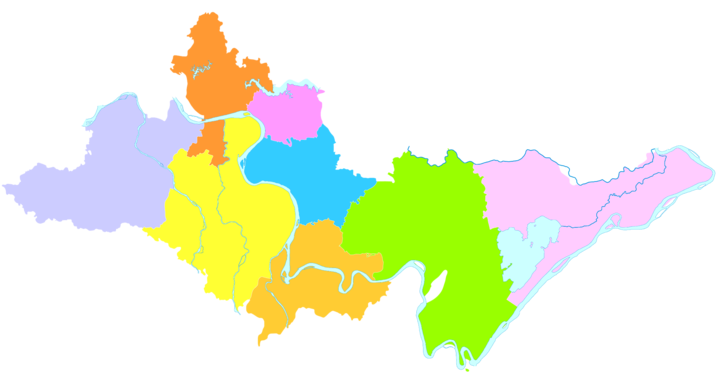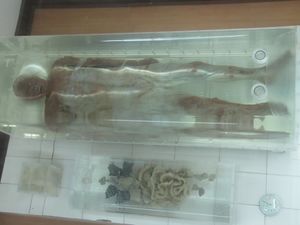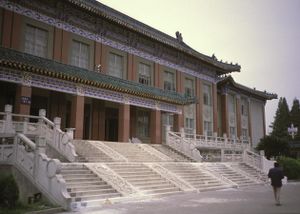جينگژو
جينگژو
荆州市 Jingzhou | |
|---|---|
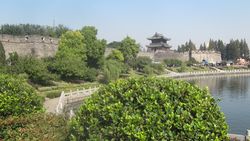 Jingzhou old city wall. | |
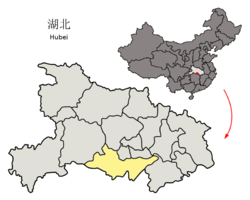 موقع مدينة جينگژو في هوبـِيْ | |
| الإحداثيات: 30°20′N 112°13′E / 30.333°N 112.217°E | |
| Country | China |
| Province | Hubei |
| المساحة | |
| • Prefecture-level city | 14٬068٫68 كم² (5٬431٫95 ميل²) |
| • الحضر | 1٬562٫2 كم² (603٫2 ميل²) |
| • العمران | 1٬562٫2 كم² (603٫2 ميل²) |
| التعداد (2010 census[1]) | |
| • Prefecture-level city | 5٬691٬707 |
| • الكثافة | 400/km2 (1٬000/sq mi) |
| • Urban | 1٬154٬086 |
| • الكثافة الحضرية | 740/km2 (1٬900/sq mi) |
| • العمرانية | 1٬154٬086 |
| • الكثافة العمرانية | 740/km2 (1٬900/sq mi) |
| منطقة التوقيت | UTC+8 (China Standard) |
| Licence plate prefixes | 鄂D |
| الموقع الإلكتروني | http://www.jingzhou.gov.cn/ |
| جينگژو | |||
|---|---|---|---|
 "Jingzhou", as written in Chinese | |||
| الصينية المبسطة | 荆州 | ||
| الصينية التقليدية | 荊州 | ||
| البريد | Kingchow | ||
| |||
جينگژو (Chinese: 荆州؛ إنگليزية: Jingzhou) هي prefecture-level city in southern Hubei, China, located on the banks of the Yangtze River. As of the 2010 census, its total population was 5,691,707, 1,154,086 of whom resided in the built-up (or metro) area comprising the two urban districts.
Jingzhou's central urban area has grown out of a city historically known as Shashi; this name is preserved in the name of Shashi District, which includes the city's historical center, as well as in the names of a number of local facilities, such as Shashi Airport and a railway freight station.
الجغرافيا والمناخ
Jingzhou occupies an area of 14,067 square kilometres (5,431 sq mi) with a topography rising from east to west. It is covered by a dense network of waterways, as well as lakes, and is located in the middle reaches of the Yangtze River on the Jianghan Plain. Downstream to its east lies Wuhan, the provincial capital and to the west the city of Yichang, the Three Gorges, and finally Chongqing Municipality. Jingmen City, also in Hubei, lies to the north; to its south are Yueyang and Changde, both in Hunan Province.
Jingzhou has a humid subtropical climate (Köppen Cfa), with hot, humid summers, and damp, chilly, but drier winters. Monthly daily average temperatures range from 4.1 °C (39.4 °F) in January to 28.0 °C (82.4 °F) in July. The area receives 1,800 to 2,000 hours of sunshine per year and has a frost-free period of 242−263 days annually.[2]
| أخفClimate data for جينگژو (1971−2000) | |||||||||||||
|---|---|---|---|---|---|---|---|---|---|---|---|---|---|
| Month | Jan | Feb | Mar | Apr | May | Jun | Jul | Aug | Sep | Oct | Nov | Dec | Year |
| Record high °C (°F) | 21.9 (71.4) |
25.0 (77.0) |
28.0 (82.4) |
33.1 (91.6) |
35.4 (95.7) |
37.2 (99.0) |
37.9 (100.2) |
38.6 (101.5) |
36.8 (98.2) |
33.2 (91.8) |
29.3 (84.7) |
21.1 (70.0) |
38.6 (101.5) |
| Mean daily maximum °C (°F) | 8.1 (46.6) |
10.2 (50.4) |
14.2 (57.6) |
21.1 (70.0) |
26.1 (79.0) |
29.3 (84.7) |
32.0 (89.6) |
32.0 (89.6) |
27.5 (81.5) |
22.4 (72.3) |
16.3 (61.3) |
10.8 (51.4) |
20.8 (69.5) |
| Daily mean °C (°F) | 4.1 (39.4) |
6.0 (42.8) |
10.1 (50.2) |
16.7 (62.1) |
21.6 (70.9) |
25.2 (77.4) |
28.0 (82.4) |
27.7 (81.9) |
23.0 (73.4) |
17.6 (63.7) |
11.7 (53.1) |
6.4 (43.5) |
16.5 (61.7) |
| Mean daily minimum °C (°F) | 0.9 (33.6) |
2.8 (37.0) |
6.6 (43.9) |
12.9 (55.2) |
17.9 (64.2) |
21.8 (71.2) |
24.7 (76.5) |
24.4 (75.9) |
19.6 (67.3) |
14.0 (57.2) |
8.0 (46.4) |
2.9 (37.2) |
13.0 (55.5) |
| Record low °C (°F) | −14.9 (5.2) |
−9.2 (15.4) |
−1 (30) |
−0.1 (31.8) |
9.8 (49.6) |
13.0 (55.4) |
18.1 (64.6) |
17.5 (63.5) |
10.6 (51.1) |
1.7 (35.1) |
−3 (27) |
−6.3 (20.7) |
−14.9 (5.2) |
| Average precipitation mm (inches) | 29.6 (1.17) |
44.8 (1.76) |
75.4 (2.97) |
107.6 (4.24) |
140.8 (5.54) |
159.9 (6.30) |
151.2 (5.95) |
119.9 (4.72) |
89.3 (3.52) |
86.8 (3.42) |
55.2 (2.17) |
23.4 (0.92) |
1٬083٫9 (42.68) |
| Average precipitation days (≥ 0.1 mm) | 8.2 | 9.1 | 12.9 | 12.8 | 13.3 | 13.0 | 10.5 | 9.4 | 9.2 | 10.6 | 8.5 | 6.8 | 124.3 |
| Source: Weather China[2] | |||||||||||||
الديمغرافيا
According to the 2010 Census, the prefecture-level city of Jingzhou has 5,691,707 inhabitants and a population density of 405 inhabitants per km².[3]
الادارة
The prefecture-level city of Jingzhou has jurisdiction over two districts, three county-level cities and three counties. The information here presented uses the metric system and data from the 2010 Census.
| Map | |||||
|---|---|---|---|---|---|
| الاسم | الصينية المبسطة | Hanyu Pinyin | المساحة (K㎡) |
التعداد (2010) |
الكثافة (/كم²) |
| Jingzhou District | 荆州区 | Jīngzhōu Qū | 1,046 | 553,756 | 529 |
| مديرية شاشي | 沙市区 | Shāshì Qū | 469 | 498,526 | 1,063 |
| Songzi City | 松滋市 | Sōngzī Shì | 2,235 | 765,911 | 343 |
| Shishou City | 石首市 | Shíshǒu Shì | 1,427 | 577,022 | 404 |
| Honghu City | 洪湖市 | Hónghú Shì | 2,519 | 819,446 | 325 |
| Jiangling County | 江陵县 | Jiānglíng Xiàn | 1,032 | 331,344 | 321 |
| Gong'an County | 公安县 | Gōng'ān Xiàn | 2,258 | 881,128 | 390 |
| Jianli County | 监利县 | Jiānlì Xiàn | 3,118 | 1,162,770 | 373 |
History
Jingzhou has been a transportation hub and commodity distribution center for 6,000 years.
The ancient city of Jingzhou forms what is now the main urban area of Jiangling County, which is one of the counties within Jingzhou City. Situated in the middle reaches of the Yangtze River, this has been a strategic location of military importance since ancient times.
Ying, within the borders of present-day Jingzhou, was the capital of 20 kings over 411 years of the State of Chu during the Spring and Autumn and Warring States periods of the Zhou Dynasty (1046 BCE - 256 BCE).
The city is said to have been built with earth by Guan Yu in the Three Kingdoms period. During the Southern and Northern Dynasties period, it was the capital of the Western Liang. In the Five Dynasties and Ten Kingdoms period, it was the capital of the Nanping State.
المشاهد
Numerous sites have been preserved from the Chu State period, including the ruins of five Chu cities, 73 sites featuring Chu Culture and more than 800 ancient tombs, including those of 18 Chu kings.
There are also historical sites dating to the Three Kingdoms period, such as the Wulin Battlefield (where the Battle of Red Cliffs took place) and the Huarong Path.
The city walls were rebuilt in 1646 and measure 9 metres (30 ft) high and 10 metres (33 ft) thick. The perimeter of the wall extends for 10.17 kilometres (6.32 mi). The city walls, city gates, watchtowers, and battlements have all been well maintained. Many of the towers on top of the majestic city gates have been damaged or rebuilt, leaving only the Chaozong Tower which was rebuilt in 1838 on the Gongji Gate.
The Jingzhou museum has on display a well-preserved 2,000-year-old male corpse. Also on display are silk and lacquerware from the Warring States period.
النقل
- China National Highway 207
- China National Highway 318
- Jingzhou Railway Station on the Wuhan-Yichang Railway, with frequent passenger service to Yichang and Wuhan
- Jingmen-Shashi Railway (freight only)
- Shashi Airport in Shashi district
المدن الشقيقة
 Yanggu County, Gangwon, South-Korea
Yanggu County, Gangwon, South-Korea Port Chester, New York, United States
Port Chester, New York, United States
انظر أيضاً
المراجع
- ^ http://www.citypopulation.de/php/china-hubei-admin.php
- ^ أ ب 荆州城市介绍 (in Chinese). Weather China. Retrieved 2012-02-04.
{{cite web}}: CS1 maint: unrecognized language (link) - ^ (صينية) Compilation by LianXin website. Data from the Sixth National Population Census of the People's Republic of China
وصلات خارجية
- CS1 uses الصينية-language script (zh)
- Articles with hatnote templates targeting a nonexistent page
- Short description is different from Wikidata
- Articles containing صينية-language text
- Pages using gadget WikiMiniAtlas
- Articles containing simplified Chinese-language text
- Articles containing إنگليزية-language text
- Pages using Lang-xx templates
- مدن هوبـِيْ
- أماكن مأهولة على نهر يانگتسى
- Prefecture-level divisions of Hubei
- Former prefectures in Hubei
- Prefectures of the Sui dynasty
- Prefectures of the Tang dynasty
- Prefectures of the Ming dynasty
- Prefectures of the Qing dynasty
- موانئ الصين

